
 |
|
|
|
A beautifully produced and directed thriller, Ride the Pink Horse is noir for its amoral hero and its suggestion that the postwar years were a happy time for war profiteers like the film's villain. Director Robert Montgomery's previous film The Lady in the Lake showed the former MGM light comedy star of responding to the war's end by emulating Dick Powell's career gear-change and playing Raymond Chandler's tough guy detective hero Philip Marlowe. Lady was a major 'novelty' experiment -- Montgomery's camera assumed the literal POV of the Marlowe character throughout most of the film. Ride the Pink Horse is more conventional and much more effective: the actor who once spent entire movies drinking champagne with Joan Crawford, is now a dead-serious screen tough guy. 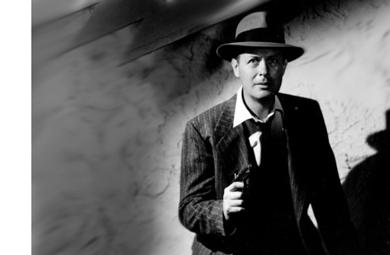
The film is also the work of producer Joan Harrison, the former Alfred Hitchcock secretary, associate and writer who broke into producing with Universal's excellent wartime noir Phantom Lady. Ms. Harrison's literary adaptations have extra depth as well as a surface elegance. Writers Ben Hecht and Charles Lederer lighten author Dorothy B. Hughes nasty characters and provide a positive ending. It's slightly soft noir but tough enough in the details. Where it really goes wrong is in its racial attitude. Ride the Pink Horse takes the time and effort to engage its anti-hero with the Southwestern Mexican-American culture, yet what it presents is the same old condescending vision, with 'sensitivity'. When New York hoodlum Lucky Gagin (Robert Montgomery) arrives in the sleepy New Mexico border town of San Pablo, government cop Bill Retz (Art Smith) knows that trouble has arrived. Gagin's pal 'Shorty' has been murdered back East, and it's assumed that the responsible party is Frank Hugo (Fred Clark), a ruthless businessman. Retz warns Gagin against getting vengeance for Shorty, but Gagin goes forward, roughing up Hugo's secretary Jonathan (Richard Gaines) and sneering at the come-on he gets from Hugo's mercenary girlfriend Marjorie Lundeen (Andrea King). Lucky instead finds a fast friend in Pancho (Thomas Gomez), who operates an ancient carousel for San Pablo's children. Even more help is young Pila (Wanda Hendrix), a virtuous teen in traditional Mexican peasant garb. Pila takes it upon herself to protect Gagin and worships him, despite his cynical insults and general mistrust. We soon find that Gagin has not come to kill but instead to finish what Shorty started: blackmail Frank Hugo with evidence that the war profiteer cheated the government. Gagin's a tough customer, but he doesn't realize how dirty the opposition is willing to play. 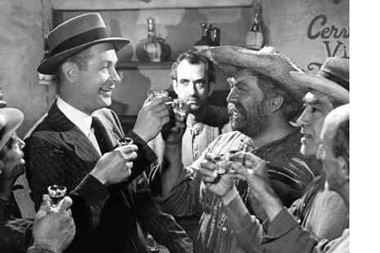
The highly polished noir Ride the Pink Horse is directed with elegance and economy. Robert Montgomery uses several complicated long takes that don't draw attention to themselves, not even the opening scene's shot that follows Gagin from the bright New Mexico sunshine into a bus terminal and watches him perform almost four minutes of complicated business with props and furniture. Unlike many actor-directors that simply stick with faces, Montgomery lets us slowly discover what Gagin is up to. Gagin makes friends in a hostile Mexican bar with smiles and free drinks. But he also brushes off Pila's open-faced honesty, patronizing and insulting her. Gagin's manners with Hugo's associates are no less brutal, seeing as how he knocks Jonathan unconscious and repels Marjorie's transparent advances with contemptuous put-downs. Gagin substitutes money for human interaction, paying a Native American bellboy for various errands and tossing cash at Pila with the assumption that she's giving him goo-goo eyes because she's looking for a handout. Frank Hugo has done everything to make a buck, including murder. His idea of hospitality is to flatter Gagin's blackmail bid, calling it a good business move. Just as the Federal cop Retz warns, even Gagin doesn't realize how ar Hugo will go to avoid forking over $30,000. Hugo and Marjorie instead lead Lucky into an ambush, which he survives only through the intervention of his new Spanish-speaking friends. Pink Horse is not an uplifting story about a brute city thug who learns that real human values can be found with the noble poor. Pancho and Pila take risks and suffer beatings without betraying Gagin, even though they have nothing to gain by doing so. A really cynical noir would have Gagin simply leave without acknowledging his debt, but Harrison and Montgomery instead opt for sentimental farewells. On the surface Gagin has made two friends, but has he really 'connected' with them? Certainly not. 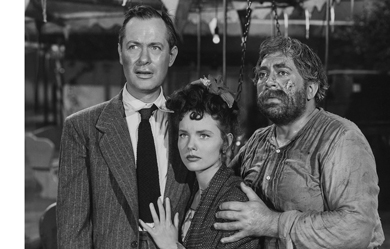
(this spoiler discussion covers the films' ending) Just by embracing its Mexican-American setting, Ride the Pink Horse convinces many that it is sensitive to the cultural divide. What it really does is apply, with more finesse, the racist viewpoint that was the majority consensus in America in 1947. A stranger in a strange barrio, Gagin treats everyone with standoffish contempt until he finds himself in a hostile barroom, where he buys the approval and good cheer of the locals with ten dollars worth of free drinks. Pancho instantly reveals himself as an underclass 'Gunga Din' sidekick type, willing to put his life on the line for a handsome caballero he knows absolutely zero about. Ah, such earthy stereotypes are forever looking for Misters / Señors / Bwanas / Kimosabes, to whom they can pledge dog-like devotion. Poor people can certainly be welcoming, generous and loyal friends to near- strangers, like any other ethnic group. But they aren't idiots. Wanda Hendricks' imitation of a Latina is okay, even if self-respecting Latins see her as an insult. Why? As good as Hendricks is in the role, her Pila is still the magical 'dusky savage', a barefoot peasant version. She's too young and virtuous to fully understand what her two girlfriends are up to when they 'go' with men. She's given the intuition that Gagin has a dramatic destiny, and that she must play a part in it. The film isn't racist because it shows Gagin and Marjorie ignoring Pila or condescending to her, but because it idealizes her as a non-white 'princess', who is magical but cannot end up with the hero. For the Production Code bigots, a romantic finale is unthinkable; Hollywood was still solving problems of this sort by having the non-white girl jump into a volcano. The final scene is touching, and rather novel when Pila 'converts' her experience with Gagin into a legend with herself as the heroine. Her reaction is the reaction of a small child, when our expectation throughout has been that she could be Gagin's lover, if only he'd look at her differently. 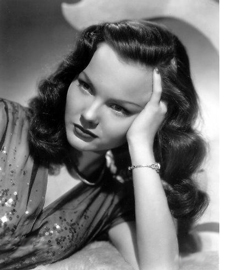
Lucky's character arc is actually quite credible. To the extent that he's able he appreciates the help of his Mexican-American friends. As Gagin hasn't known such selfless loyalty since he was in combat, he sincerely offers to cut Pancho in on his take. But the expected cash doesn't come, he drops the issue. Pila is a special person, yet the most he can offer her is a peck on the cheek. All parties seem aware that the two classes and cultures are incompatible. Anyway, 'the money would only corrupt the primitive Mexicans.' Ride the Pink Horse is fascinating. We like all the characters, but its very desire to 'play fair' with the Mexican-American experience makes its conservatism all the more unpleasant. 1 The film's ancient carousel is well used. Besides suggesting the title, it becomes a poetic locator for Pila's 'magic'. When Gagin decides to reward Pila, he pays for a special midnight ride for her. Later, when Gagin is wounded, Pila hides him on the revolving carousel, which forms a 'magic circle' protecting him from the violent threat only a couple of feet away. The corresponding Anglo talisman that Gagin, Marjorie and Hugo fight for is a piece of paper, a very un-magical canceled check that marks the boundary between riches and prison. Robert Montgomery's performance is remarkable, as Gagin is likeable despite being a rather thickheaded tough guy. He's capable of besting two knife fighters at the same time, but his only clever remarks are nasty put-downs: "She has a dead fish where her heart ought to be." The hesitant affection he feels for Pancho and Pila is the most warmth he's capable of generating. 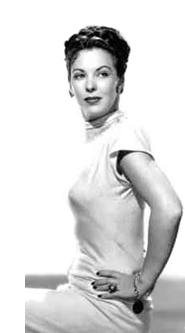
All the performances are commendable. I accept Wanda Hendrix is charming as the spft-spoken Pila. Curiously, although Thomas Gomez is ethnically Spanish his accent is a little rocky, as if he were reaching into his background for the language. Andrea King (The Beast with Five Fingers, Red Planet Mars) is convincingly venal as the schemer who earns Gagin's words about hearts and dead fish. Fred Clark is again a convincing wealthy crook; only later would Clark's many comedy roles change our perception of him. Dedicated noir fans have a special affection for Art Smith, familiar from several leftist efforts, like Try and Get Me! Smith's government agent looks small and harmless here, but he's the one to make a show of force at the finale. The only filmic character who tops him for unexpected G-man heroism is Werner Peters' Hieronymus B. Mistelzweig in Fritz Lang's 1,000 Eyes of Dr. Mabuse. Both look like Mickey Rooney but fight like James Bond. So Ride the Pink Horse winds up inverting expectations. Lucky Gagin turns out not to be hero in disguise, but a real blackmailer looking for a big score. Quaint, sentimentalized Mexican-Americans do good things for no reward except to share in the suffering, and when all is done they go back to being quaint. No matter how one feels about this odd picture, it has many genre and stylistic surprises. Don Siegel remade the movie in the early 1960s as The Hanged Man, with Robert Culp, Edmond O'Brien and Vera Miles. The setting was changed to the New Orleans Mardi Gras. The Criterion Collection's Blu-ray of Ride the Pink Horse is a clean and handsome scan encoding of this polished studio production. Russell Metty's cinematography seamlessly blends the locations in Santa Fe with studio work back at Universal. The La Fonda Hotel may be a real location despite being so beautifully lit. 
Criterion has two new extras for the picture. Imogen Sara Smith hosts a featurette that examines the movie in noir terms, while the commentary by Alain Silver and James Ursini goes into great detail with the shooting, helping us to appreciate the talented director. He Montgomery directed only six times and this picture is by far his best. Also included is a 1947 radio adaptation starring Montgomery, Gomez and Hendrix. The foldout insert contains an essay by Michael Almereyda. The attractive cover art stylizes the show in the form of a Mexican mural, which in this context adds insult to injury.
On a scale of Excellent, Good, Fair, and Poor,
Ride the Pink Horse Blu-ray Footnote: 1. By contrast, when the 'liberal' film noir Border Incident takes on the injustices and prejudices against Mexicans, the subject is so strong that it dominates the movie, which is at least 60% social protest. Ride the Pink Horse has no political agenda, therefore its cultural starting point is the familiar one that pictures the Mexican-Americans of San Pablo as a colorful underclass, foreigners in their own country. As a denizen of the underworld, Gagin should be less socially acceptable than they are, but the ethnic burden is heavier than the moral one.
It's interesting to compare Ride the Pink Horse's depiction of San Pablo's Mexican-Americans with the treatment of minority characters in Val Lewton's productions made during the war. The Latins and blacks in The Leopard Man, Curse of the Cat People and I Walked With a Zombie are sometimes not well written or performed, but they're all afforded equal respect with the Anglos. They're also fully conscious, thinking adults, not semi-primitive sentimentalized 'wildlife' as in Harrison and Montgomery's movie.

The version of this review on the Savant main site has additional images, footnotes and credits information, and may be updated and annotated with reader input and graphics.
Review Staff | About DVD Talk | Newsletter Subscribe | Join DVD Talk Forum |
| ||||||||||||||||||